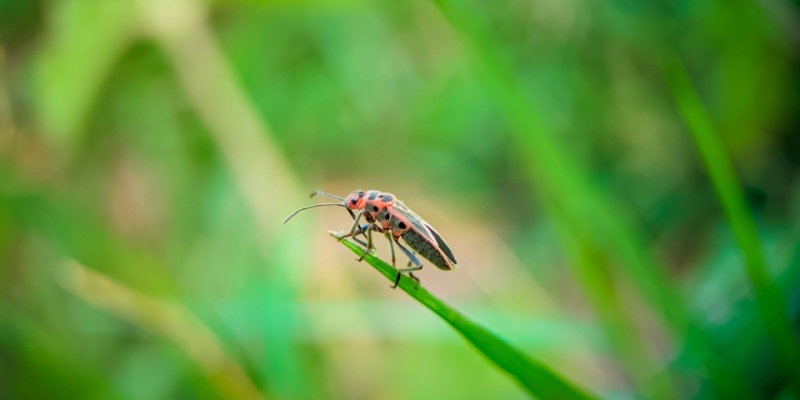When brown or damaged patches appear in your Central Ohio lawn, the culprit might be lurking just beneath the surface. Lawn pests can quickly transform a lush, green yard into a patchy, unhealthy mess. At Weed Busters, we’ve helped countless Columbus homeowners identify and address pest infestations. Here’s what you need to know about the most common lawn pests in our region and how to protect your grass from these hungry invaders.
The Most Common Lawn Pests in Central Ohio
White Grubs
Identification:
- C-shaped, white to cream-colored larvae with brown heads
- Typically ½ to 1 inch long
- Found in the soil, feeding on grass roots
Damage Signs:
- Irregular patches of wilting, browning grass that can be easily pulled up like a loose carpet
- Increased activity from skunks, raccoons, or birds digging in your lawn
- Most visible damage occurs in late summer and early fall
White grubs are the larvae of several beetle species, including Japanese beetles, June bugs, and European chafers. They feed on grass roots, severing the plant’s connection to water and nutrients in the soil.
Chinch Bugs
Identification:
- Small insects (about ⅕ inch) with black bodies and white wings
- Nymphs are reddish with a white band
Damage Signs:
- Yellowing grass that gradually turns brown and dies
- Damage typically begins in sunny, dry areas near sidewalks or driveways
- Most active during hot, dry periods of summer
Chinch bugs feed by piercing grass blades and injecting a toxin that causes the grass to wilt and die. They prefer sunny, open areas and thrive during hot, dry conditions.
Sod Webworms
Identification:
- Caterpillar-like larvae, up to ¾ inch long
- Grayish-brown with dark spots
Damage Signs:
- Small, ragged brown patches that increase in size
- Grass blades appear notched or chewed
- Moths (adult stage) flying in a zigzag pattern over the lawn at dusk
These pests feed on grass blades at night, hiding in silk-lined tunnels in the thatch layer during the day. In Central Ohio, damage is typically most severe in July and August.
Billbugs
Identification:
- Adult weevils are black or brown with a distinctive snout
- Larvae are white, legless grubs with cream-colored bodies
Damage Signs:
- Stems break easily at the crown when pulled
- Small, scattered dead patches that expand over time
- Sawdust-like waste (frass) visible in crowns and thatch
Billbugs damage lawns when both adults and larvae feed on grass stems, crowns, and roots, with damage often becoming apparent in early summer.
How to Determine If Pests Are Your Problem
Before treating for pests, confirm their presence with these simple tests:
- The Tug Test:
Gently pull on damaged grass. If it comes up easily with few roots attached, grubs may be the culprit.
- The Float Test:
Mix a few tablespoons of dish soap with a gallon of water and pour over a square yard of suspected infested turf. Wait 10 minutes—insects will rise to the surface.
- The Dig Test:
Cut a 1-foot square section of sod about 2 inches deep and examine the soil for grubs or other pests.
Effective Control Strategies for Ohio Lawn Pests
Cultural Practices
- Maintain proper mowing height (3-3.5 inches for most Ohio lawns)
- Water deeply but infrequently to promote deep root growth
- Reduce thatch through core aeration
- Overseed with endophyte-enhanced grass varieties that naturally resist certain insects
Biological Controls
- Apply beneficial nematodes or milky spore for grub control
- Encourage natural predators like birds by maintaining bird feeders near your lawn
- Choose organic options like neem oil or insecticidal soap for light infestations
Chemical Treatments
For severe infestations, targeted insecticides may be necessary:
- Preventative Grub Control: Apply in early summer (June-July) before eggs hatch
- Curative Treatments: Apply when pests are actively feeding and near the soil surface
- Spot Treatments: Target specific areas rather than treating the entire lawn when possible
The Weed Busters Approach to Pest Management
At Weed Busters, we practice Integrated Pest Management (IPM), which combines:
- Accurate pest identification
- Regular monitoring
- Cultural controls to improve lawn resilience
- Biological controls when appropriate
- Targeted chemical treatments only when necessary
This approach ensures effective pest control while minimizing environmental impact.
Prevention: The Best Defense
The most effective way to manage lawn pests is to prevent them from becoming established:
- Maintain a healthy, stress-free lawn through proper fertilization and watering
- Address compaction and drainage issues that weaken grass
- Conduct regular inspections during peak pest seasons
- Apply preventative treatments if your lawn has a history of infestation
Don’t let lawn pests undermine your efforts to maintain a beautiful yard. With proper identification and timely intervention, you can protect your Central Ohio lawn from these destructive invaders. Contact Weed Busters for a comprehensive lawn pest assessment and customized treatment plan tailored to your specific situation.

